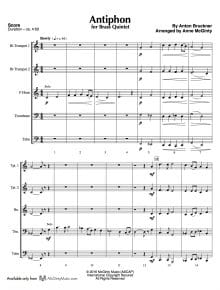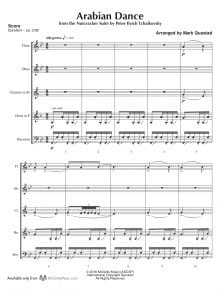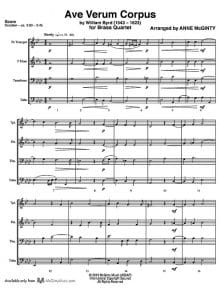Search Music
Music Categories
PDF Download Only
Purchase. Print. Play.
-
Antiphon – Brass Quintet
Anton Bruckner (1824 – 1896) was an Austrian composer known for his monumental symphonies, masses and motets. He was a simple man with an intense devotion to the spiritual life.
This motet was written in 1878 and scored for solo tenor, choir and organ. The complete title is Antiphon – Tota pulchra es Maria. It’s not known when he re-scored it for SATB. Both versions feature a dialog between a soloist and the full quintet. His use of sudden contrasts of timbre and dynamics as well as some unexpected harmonic choices make this piece a welcome addition to the repertoire.
Composer: Anne McGinty
Instrumentation: 2 Bb Trumpets, F Horn, Trombone & Tuba
Duration/# of Pages: ca. 4:50 / 11 pages, 8.5″ x 11″
Key: N/A -
Antiphon – Flute Choir
Anton Bruckner (1824 – 1896) was an Austrian composer known for his monumental symphonies, masses and motets. He was a simple man with an intense devotion to the spiritual life.
This motet was written in 1878 and scored for solo tenor, choir and organ. The complete title is Antiphon – Tota pulchra es Maria. It’s not known when he re-scored it for SATB. Both versions feature a dialog between a soloist and the full flute choir. His use of sudden contrasts of timbre and dynamics as well as some unexpected harmonic choices make this piece a welcome addition to the repertoire.
Composer: Anne McGinty
Instrumentation: 4 C Flutes, Alto Flute & Bass Flute
Duration/# of Pages: ca. 4:35 / 12 pages, 8.5″ x 11″
Key: N/A -
Arabian Dance – Woodwind Quintet
The Suite of movements extracted by Tchaikovsky from his ballet music for The Nutcracker was an immediate success. As prevalent as the complete ballet The Nutcracker is today, it is hard to imagine that it took years, and perhaps the staging of George Balanchine, for it to become popular.
Some of the most memorable pieces from the suite are the Characteristic Dances. In Act II of the ballet, these movements are employed to introduce different residents of the “Land of Sweets.” Tchaikovsky’s orchestration makes adept use of wind instrument color. This translates very effectively in arrangements for the woodwind quintet.
The Arabian Dance (Danse arabe) makes use of hypnotic ostinato and reed sounds to create a wonderful piece of Orientalia. In the ballet, this music introduces coffee.
An optional Tambourine part is included; however, it is not notated in the score.
Composer: Mark Questad
Instrumentation: Flute, Oboe, Clarinet, F Horn & Bassoon
Duration/# of Pages: ca. 3:00 / 18 pages, 8.5″ x 11″
Key: GmComposer: Mark Questad
Instrumentation: Flute, Oboe, Clarinet, F Horn & Bassoon
Duration/# of Pages: ca. 3:00 / 17 pages, 8.5″ x 11″
Key: Gm -
Ave Verum Corpus (Byrd) – Brass Quartet
Ave verum corpus (Hail, true body) is based on a 14th century poem. This musical setting by William Byrd (1543 – 1623) is considered one of his finest works. A student of Thomas Tallis, William Byrd was the leading English composer of his time, a great master of the Renaissance along with Giovanni Palestrina and Orlando de Lassus, and left a huge legacy of printed music.
The false relation, the E natural in the trumpet and the E flat in the tuba in measure 2 was Byrd's way of emphasizing the word verum.
Excerpt graciously provided by members of the Tower Brass Quintet.
Composer: Anne McGinty
Instrumentation: Trumpet, Horn, Trombone & Tuba
Duration/# of Pages: ca. 3:30 / 7 pages, 8.5″ x 11″
Key: N/A




